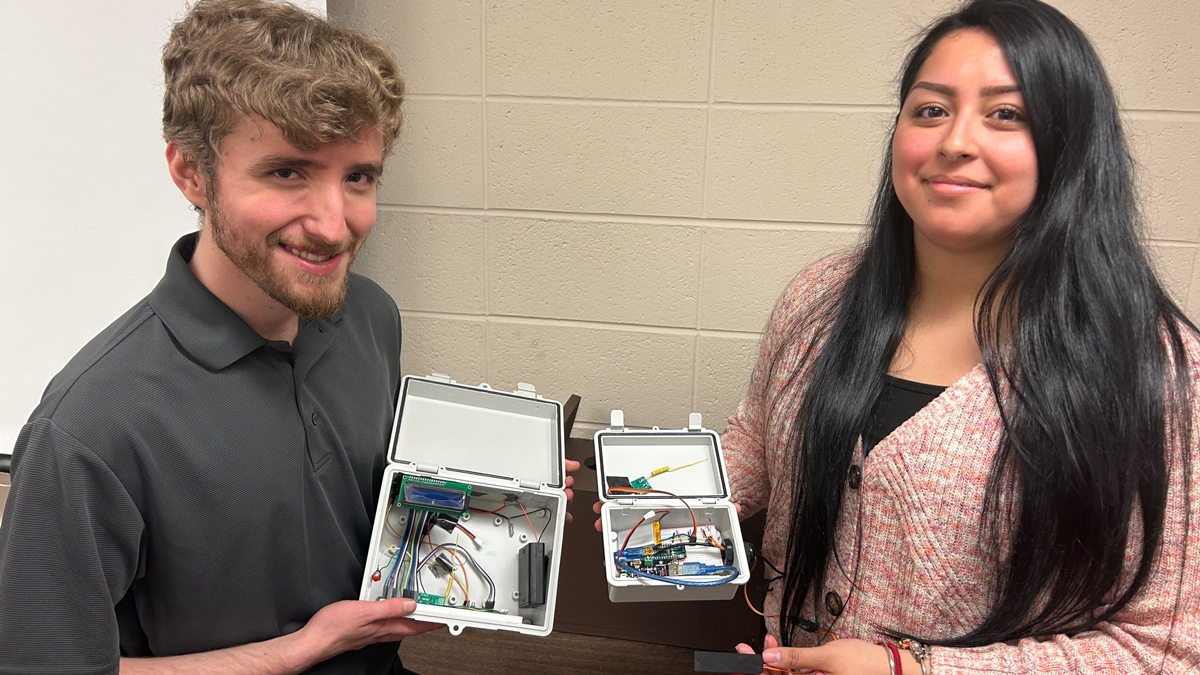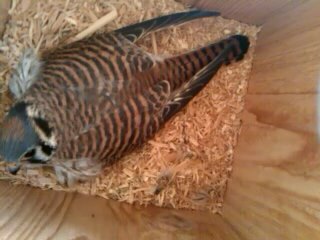
SIU electrical engineering technology graduates Bradley Thompson and Melissa Flores hold the transmitter and receiver for a new system they developed to help a Central Illinois conservation group monitor kestrel nesting boxes. Below: A female kestrel minds her eggs in a nesting box provided by the Lincoln Land Association of Bird Banders. (Photos provided)
May 15, 2023
SIU students invent device to easily monitor kestrels nesting in high places
CARBONDALE, Ill. – An engineering duo at Southern Illinois University Carbondale is using high technology to solve a problem for an avian conservation group in Central Illinois: monitoring nesting kestrels in hard-to-reach places.
Melissa Flores and Bradley Thompson, both recent graduates in SIU’s electrical engineering technology program, are making it much easier for members of the Lincoln Land Association of Bird Banders to tell if a kestrel has taken up residence in one the group’s 60 bird boxes scattered around the Springfield area. The group is made up of dedicated and licensed banders and trained volunteers who support the conservation and scientific study of native birds.
Every year, the group helps capture and band American kestrels nesting the area. The small falcons, common throughout the United States in both rural and urban environments, migrate seasonally and tend to fly or perch over open country before swooping down to prey on small mammals, lizards or large insects.
The birds migrate back to Central Illinois during a four-week period between April and May.
 Checking the occupancy status of each of the nesting boxes at least once a week during that time, however, can be an involved task requiring a small crew of volunteers, a ladder and a minivan.
Checking the occupancy status of each of the nesting boxes at least once a week during that time, however, can be an involved task requiring a small crew of volunteers, a ladder and a minivan.
Lucky for the conservation group’s leader, Holly Thompson, her son has spent the last four years learning how to solve such problems with technology.
“Yes, my mom is the president of the LLABB, and here I am solving the problem,” Thompson said. “It can be a pretty messy job, with people hauling a ladder, climbing it, steadying it. Our job was to make this into a chore that a single person could accomplish in a single afternoon.”
Flores and Thompson’s system uses an infrared sensor in a custom-designed, 3-D printed case to “see” when a kestrel enters or exits a particular box. Each time it is triggered, it transmits a signal to a receiver conveniently located at the bottom the poles, which are 6 feet high or higher. A volunteer can then walk up and read a screen that will tell how many times the device has been triggered, as well as whether the box is currently occupied based on an even or odd number in the count.
The Kestrel Box Occupancy Detector, which will be put in place next year and costs about $100 each, also is protected from the weather and does not disturb the bird in any way. A solar panel recharges the batteries in the transmitter unit, while the receiver’s batteries last for about a month.
“We had to look at it from a problem-solving point of view and be creative with how we approached it,” said Flores, from the West Lawn neighborhood of Chicago.
Thompson, of Scott Air Force Base, agreed.
“We were able to show just how helpful modern technology, such as embedded computing and wireless technology, can be in wildlife to monitor the nesting activity,” he said.
Thompson’s mother, Holly, said determining which boxes are active is critical to implementing management strategies.
“Other species, even invasives such as the common starling, use these boxes as well, so the future will tell if an active nest is a successful nest,” she said. “Regardless, this project will serve as a starting point to a future system of remote monitoring of these boxes.”
Carl Spezia, associate professor in the School of Applied Engineering and Technology at SIU, said the senior design project portion of the electrical engineering technology program, is intended to make students pull together all the skills they’ve learned to solve a real-world problem.
“They spend the first couple years in the program really learning their tools,” Spezia said. “Once they have those, they can use their own creativity and teamwork to find technology-based solutions to problems.”
Past projects have included spice dispensers for disabled cooks and a robot designed to move scenery around on a theater stage, among others, he said.
Thompson and Flores, both of whom have jobs lined up after graduation on Saturday (May 13), said the communication and teamwork skills they used working together to solve the problem will serve them well in their chosen careers.
